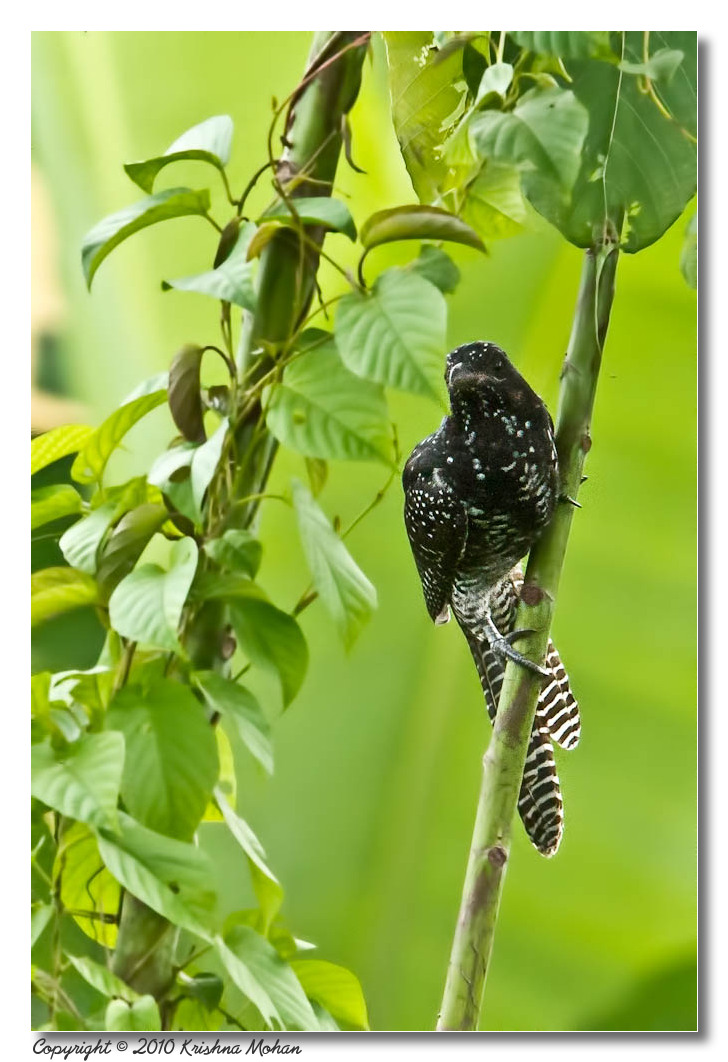
This female Asian Koel (Eudynamys scolopaceus) is a member of the cuckoo order of birds, the Cuculiformes. It is found in South Asia, China, and Southeast Asia. It forms a superspecies with the closely related Black-billed and Pacific Koels which are sometimes treated as subspecies. The Asian Koel is a brood parasite that lays its eggs in the nests of crows and other hosts, who raise its young. They are unusual among the cuckoos in being largely frugivorous as adults. The name koel is echoic in origin and the bird is a widely used symbol in Indian poetry.
The Asian Koel is a large, long-tailed, cuckoo at 45 cm. The male is glossy bluish-black, with a pale greenish grey bill, the iris is crimson, and it has grey legs and feet. The female is brownish on the crown and has rufous streaks on the head. The back, rump and wing coverts are dark brown with white and buff spots. The underparts are whitish, but is heavily striped.
They are very vocal during the breeding season (March to August in South Asia), with a range of different calls. The familiar song of the male is a repeated koo-Ooo. The female makes a shrill kik-kik-kik… call.

The Asian Koel is a bird of light woodland and cultivation. It is a mainly resident breeder in tropical southern Asia from India and Sri Lanka to south China and the Greater Sundas. They have great potential in colonizing new areas, and were among the pioneer birds to colonize the volcanic island of Krakatau.
The Asian Koel is a brood parasite, and lays its single egg in the nests of a variety of birds, including the Jungle Crow, and House Crow. Males may distract the hosts so that the female gets a chance to lay an egg in the nest. More often however, the female visits the nest of the host alone. The chicks of the Koel hatched about 3 days ahead of the host chicks. Koels usually lay only an egg or two in a single nest but as many as seven to eleven eggs have been reported from some host nests. A female may remove a host egg before laying. Eggs hatch in 12 to 14 days. The young Koel does not always push out eggs or evict the host chicks, and initially calls like a crow. The young fledge in 20 to 28 days. Unlike as in some other cuckoos, the young do not attempt to kill the host chicks, a trait that is shared with the Channel-billed Cuckoos which are also largely frugivorous as adults. It has been suggested that Koels, like some other brood parasites do not evict the host chicks due presumably due to the higher cost of evicting nestmates. A small parasite may not be able to evict large host eggs or chicks from a deep Corvid nest without risking starvation and possibly accidental self-eviction.
The Asian Koel is omnivorous, consuming a variety of insects, caterpillars, eggs and small vertebrates. Adults feed mainly on fruit. They will sometimes defend fruiting trees that they forage in and chase away other frugivores. They have been noted to be especially important in the dispersal of the sandalwood tree (Santalum album) in India. Large seeded fruits are sometimes quickly regurgitated near the parent tree while small seeded fruits are ingested and are likely to be deposited at greater distances from the parent tree. They have a large gape and are capable of swallowing large fruits including the hard fruit of palms such as Arenga and Livistona.
The word “Koel” is derived from the Hindi word which is onomatopoeic in origin. The Sanskrit root is “Kokila” and the words in various Indian languages are similar. It is traditionally held in high regard for its song and held in reverence with the Manusmriti, an ancient decree protecting them from harm. These birds were once very popular in India as cagebirds. Feeding even on boiled rice, these hardy birds lived in captivity for as long as 14 years.

This bird has an strong association with the Traditional new year celebrations of Sri Lanka. In the literature around the festival, the song of the bird regarded as a heralding of the traditional new year. This bird is known as the koha in Sri Lanka by the Sinhala speaking community.
Courtesy: Wikipedia


Awesome capture…
The foreground seems slightly distracting, I would like to see some birds in flight ‘getting shot’ from you.
plz you can tell me medicale valuses of asian koel